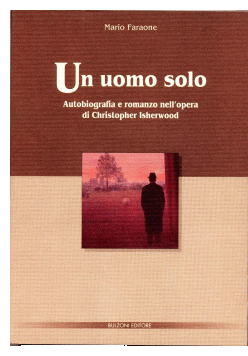Un uomo solo |
|
Abstract |
This critical and interpretative study identifies, inside Isherwood's narrative output, a steadfast development which disavows the credited vision of a creative literary route abruptly interrupted  half
way through by his conversion to the Vedanta religion. I
recompose the often too popular image
of the "two Isherwoods": on the one hand, the
"engagé" singer of a Berlin on the verge of
the Nazi abyss; on the other, the capricious Americanised
initiate to quaint oriental doctrines. Between Isherwood's so called "two phases", I
here assume and demonstrate a continuity whose nodal centre is an
interlacement between life and narrative scheme, which
creates characters balanced between
autobiographical projection and representative
objectivity. In gaining apparently intimate depth,
Isherwood's last novels throw a retrospective
glance on his career, and reveal how the author's
artistic vocation has been, from its beginning that of watching the world from the stronghold of an
honest and at times ruthless self-analysis. Far from really being that cold and detahced "camera-eye" of his too often reiterated metaphor, Isherwood, "uomo solo" ("single man"), spends every
single moment of his artistic exploration in quest of a
fruitful connection with the rest of mankind through the
coexistence of his Vedanta faith and artistic experimentalism,
to achieve a sense of unity and harmony. half
way through by his conversion to the Vedanta religion. I
recompose the often too popular image
of the "two Isherwoods": on the one hand, the
"engagé" singer of a Berlin on the verge of
the Nazi abyss; on the other, the capricious Americanised
initiate to quaint oriental doctrines. Between Isherwood's so called "two phases", I
here assume and demonstrate a continuity whose nodal centre is an
interlacement between life and narrative scheme, which
creates characters balanced between
autobiographical projection and representative
objectivity. In gaining apparently intimate depth,
Isherwood's last novels throw a retrospective
glance on his career, and reveal how the author's
artistic vocation has been, from its beginning that of watching the world from the stronghold of an
honest and at times ruthless self-analysis. Far from really being that cold and detahced "camera-eye" of his too often reiterated metaphor, Isherwood, "uomo solo" ("single man"), spends every
single moment of his artistic exploration in quest of a
fruitful connection with the rest of mankind through the
coexistence of his Vedanta faith and artistic experimentalism,
to achieve a sense of unity and harmony. |
Contents in Detail |
|
In "Chapter Three", I describe
and study thoroughly Isherwood's real change of attitude.
In my opinion such a change is already detectable in
Goodbye to Berlin and is definitely clear in "Isherwood's
dark night of the soul" (in Carolin Heilbrun's
definition of the forties) ten years of hard struggle to
find "a new tone of voice". He finds it all
right, I argue, in Prater Violet and in his numerous
essays on Vedanta, mainly in "The Gita and War"
ad in "The Problem of the Religious Novel"; but
also, and above all, in his relationship with Swami
Prabhavananda and in their so called translation of the
Bhagavad Gita. The Gita, so important for all Eastern belief and
civilisation, contains a sentence which practically
describes Isherwood's final "path to safety",
along his "long road to self understanding",
the sentence Khrishna utters to Arjuna in the field of
Kurukshetra, about the "four men who love me: the
world weary, the seeker for happiness, the seeker for
knowledge and the man of spiritual discrimination".
Since they are the four main characters of Isherwood's last
four novels, Stephen Monk in The World in the Evening,
Paul in Down there on a Visit (both dealt with in "Chapter Four"), George in A Single Man and Oliver in A Meeting by the River (analysed in "Chapter Five"), they are four progressive steps along this "path to safety" to man's
final harmony with the creation and Isherwood's final
personal, spiritual and artistic integrity. Finally, "Conclusion" examines
Isherwood's experimental and traditional techniques; his relation with the cinema (also dealt with in "Chapter Three", in my analysis of Prater Violet) his connection with
"mirror images" but above all his lifelong
relationship with Vedanta and his deep belief in cosmic
and human harmony. The "Bibliography" is an up to date coverage of the period 1978-1998, since it starts from the point in which Robert Funk's
bibliography finished, and it updates both primary works
and criticism to the present day. The section on movie
scripts and the assessment of Isherwood's religious writings
are absolutely new in their actual form, and thus this is probably the first ever filmography of Christopher Isherwood attempting to be global. |
Mario Faraone - © 2000 for texts and contents *** Web Design by V. "Diddl" Viky |